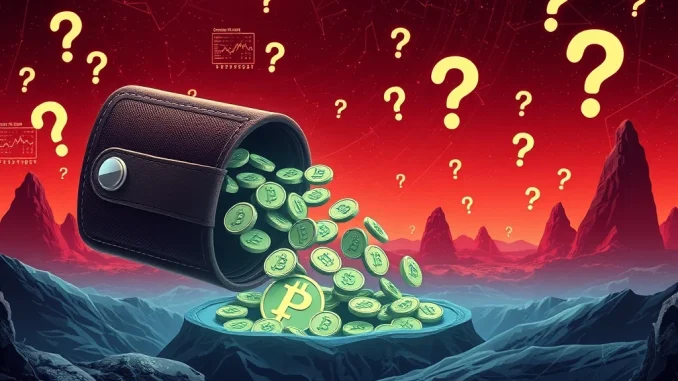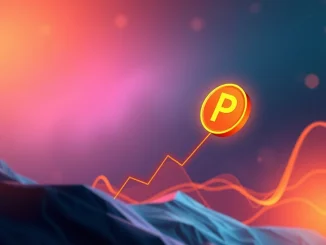
A significant, unexplained movement of 20 million Pi tokens from the Pi Network team wallet has sent ripples of concern and intense crypto market speculation through its dedicated community. This isn’t just a simple transaction; it’s a development that has ignited heated discussions about the project’s future, its elusive price target, and the very foundation of trust within the ecosystem. What exactly does this mean for the millions of Pioneers eagerly awaiting Pi Coin’s full potential?
Unpacking the Significant Pi Network Token Movement
The cryptocurrency world is no stranger to dramatic shifts, but the recent transfer of 20 million Pi tokens has undeniably captured the attention of enthusiasts and skeptics alike. This substantial sum, moved from what is understood to be the Pi Network team’s wallet, occurred without any immediate official confirmation or explanation from the project’s leadership. In a space where transparency is often paramount, this silence has naturally led to a surge of questions and concerns among the community.
Think about it: 20 million tokens is a considerable amount, especially for a project that has yet to achieve mainstream exchange listings. Such a movement, when unexplained, can easily be misinterpreted as a potential sell-off, which could have dire consequences for perceived value and community trust. While founder Dr. Nicolas Kokkalis later took to Twitter to reassure the community, stating that the team has “no plans for token sell-offs” and emphasizing adherence to the project’s roadmap and transparency principles, the initial lack of communication created a vacuum filled by speculation.
For context, consider how established cryptocurrencies like Bitcoin or Ethereum handle large transactions from core development teams. Such moves are typically accompanied by detailed announcements, providing reasons, destinations, and assurances to prevent market panic. The absence of this standard protocol for Pi Network has left many wondering about the implications for the project’s stability and its long-term vision.
The Enduring Pi Coin Price Target Dilemma
One of the most pressing questions arising from this token movement is its impact on the viability of the Pi Coin‘s long-held $0.62 price target. This target, often discussed within the community, now seems more distant and doubtful to many, particularly given the network’s unique and somewhat constrained market environment.
Here’s why the $0.62 target faces skepticism:
- Absence from Major Exchanges: Unlike most cryptocurrencies that derive their value from active trading on global exchanges, Pi Coin is conspicuously absent from these platforms. This severely limits direct trading options and, crucially, value realization for users.
- Reliance on IOU Markets: Currently, Pi Coin primarily exists within IOU (I Owe You) markets. These are unofficial, speculative markets where participants trade promises of future Pi tokens, not the actual tokens themselves on a regulated exchange. Their prices are highly volatile and often disconnected from the project’s fundamental progress.
- Limited Liquidity: The restricted trading environment means there’s very little actual token liquidity. If there’s no easy way to buy or sell large quantities of Pi without drastically affecting its price, any large token movement or potential sell-off (even if denied by the team) could theoretically overwhelm the existing market and plummet its speculative value.
The situation underscores a fundamental challenge for Pi Coin: how can a price target be sustained or achieved when the mechanisms for price discovery and liquidity are not yet fully in place? The recent token movement, without clear explanation, only exacerbates these doubts, pushing the community to question the immediate financial prospects of their accumulated Pi.
Navigating Heightened Crypto Market Speculation
The unexplained transfer of 20 million Pi tokens has predictably fueled significant crypto market speculation. In the absence of clear, timely communication, the market tends to fill the void with rumors, theories, and anxieties. For Pi Network, a project with a massive user base but a still-developing ecosystem, this speculation can be particularly potent and challenging to manage.
Why does this event trigger such intense speculation?
- Information Asymmetry: When the core team possesses critical information that the public does not, it creates an environment ripe for speculation. Investors and users are left to piece together clues, often leading to varied and sometimes contradictory conclusions.
- Uncertainty Breeds Volatility: While the lack of exchange listings curtails the immediate, widespread volatility that might affect major cryptocurrencies like Bitcoin or Ethereum, the internal and IOU markets can still experience significant swings based on sentiment. The uncertainty surrounding this large token movement directly impacts user confidence and, by extension, the perceived value in these restricted trading environments.
- Regulatory Ambiguity: The cryptocurrency landscape is already grappling with evolving regulatory frameworks. Pi Network’s unique distribution model and limited trading environment add layers of complexity. Unexplained token movements can attract unwanted attention from regulators, who might view such activities with suspicion, especially if they hint at market manipulation or lack of proper governance.
For investors, weighing the implications of such wallet activity against the network’s limited liquidity and regulatory ambiguity becomes a critical exercise. Proponents might see it as a sign of progress or internal re-organization, while skeptics might view it as a red flag, urging caution.
Addressing Critical Token Liquidity Challenges
One of the most significant hurdles for Pi Network, and a major point of concern exacerbated by the recent token movement, is the ongoing challenge of token liquidity. The project’s tokens remain largely confined to IOU markets, which, while allowing for some speculative trading, do not offer the robust, liquid environment necessary for true price discovery and value realization.
What does this “restricted trading environment” entail?
- No Direct Fiat Conversion: Users cannot directly convert their Pi tokens into fiat currency (like USD or EUR) or other major cryptocurrencies on widely recognized exchanges. This means the value of their mined Pi is theoretical rather than immediately actionable.
- Limited Trading Pairs: In IOU markets, trading pairs are often limited and the depth of the order book is shallow, making large transactions difficult without significant price impact. This is a stark contrast to established exchanges where millions of dollars worth of Bitcoin or Ethereum can be traded in seconds with minimal price fluctuations.
- Regulatory Hurdles: Achieving genuine liquidity often requires listing on major exchanges, which in turn demands compliance with various regulatory requirements, including robust KYC (Know Your Customer) and AML (Anti-Money Laundering) procedures. Pi Network is still working on its decentralized KYC process, which is a crucial step towards broader market access.
The project’s focus on foundational upgrades, including these decentralized KYC processes and preparing for Open Mainnet readiness, is vital. These steps are designed to lay the groundwork for a truly liquid and accessible market. However, until these are fully implemented and the network transitions to a public trading phase, the issue of liquidity will continue to test user confidence and limit the practical utility of Pi tokens.
The Path Forward: Key Blockchain Developments and Roadmap Adherence
Despite the current wave of speculation, Dr. Nicolas Kokkalis’s assertion that “all token allocations and movements align strictly with the stated roadmap” signals a deliberate strategy. This strategy appears to prioritize ecosystem stability and foundational blockchain developments over short-term market gains or immediate public trading.
What does this focus on the roadmap and foundational developments mean for Pi Network’s future?
- Decentralized KYC Processes: A robust and decentralized KYC system is paramount for any blockchain project aiming for mainstream adoption and regulatory compliance. It ensures the integrity of the network and prepares it for interaction with traditional financial systems.
- Open Mainnet Readiness: The transition to an Open Mainnet is the most anticipated milestone. This phase would allow external connectivity, enable developers to build on the Pi blockchain, and crucially, pave the way for potential public trading. It signifies a move from a closed, test environment to a fully operational, decentralized network.
- Ecosystem Building: Pi Network has consistently emphasized building a utility-driven ecosystem where Pi Coin can be used for goods and services. Features like wallet integrations and QR code payments are steps in this direction, aiming to establish intrinsic value beyond mere speculation.
The coming months will be crucial in determining whether Pi Coin can transition from a speculative asset, largely confined to IOU markets, to a sustainable digital currency with tangible utility and verifiable financial metrics. The success hinges on resolving liquidity issues, navigating complex regulatory frameworks, and proving its utility beyond just a theoretical promise. While the recent token movement has stirred the pot, the long-term vision remains tied to the successful execution of these core blockchain developments.
Conclusion
The recent movement of 20 million Pi tokens from the Pi Network team wallet has undeniably cast a shadow of uncertainty over the project, fueling intense crypto market speculation and raising questions about the future of Pi Coin‘s value. While founder Dr. Nicolas Kokkalis has attempted to reassure the community, the lack of immediate, detailed explanations has highlighted existing concerns around token liquidity and regulatory clarity. The project’s success now hinges on its ability to transparently address these issues, achieve Open Mainnet readiness, and demonstrate tangible utility through its ongoing blockchain developments. As the community watches closely, the coming months will be pivotal in determining whether Pi Network can truly bridge the gap from a grassroots phenomenon to a recognized, valuable digital currency in the broader crypto landscape.
Frequently Asked Questions (FAQs)
Q1: What exactly happened with the 20 million Pi tokens?
A1: Approximately 20 million Pi tokens were moved from what is believed to be the Pi Network team’s wallet. The significant aspect of this transfer was the initial lack of official explanation from the project leadership, leading to widespread speculation and concern within the community.
Q2: Why is the movement of these tokens causing such a stir?
A2: The movement is causing a stir primarily due to the large quantity of tokens involved and the absence of immediate, clear communication from the Pi Network team. This has led to speculation about potential sell-offs, impacts on the token’s price target, and broader concerns about the project’s transparency and liquidity, especially since Pi Coin is not yet listed on major exchanges.
Q3: Does this token movement affect Pi Coin’s $0.62 price target?
A3: The unexplained token movement has certainly sparked doubts about the $0.62 price target. This is largely because Pi Coin currently operates primarily in IOU markets, lacks major exchange listings, and faces significant liquidity constraints. Such a large internal transfer, without context, adds to the uncertainty surrounding its speculative value.
Q4: What are IOU markets, and why are they relevant to Pi Coin?
A4: IOU (I Owe You) markets are unofficial, unregulated platforms where users trade promises or claims of future Pi tokens. They are relevant because Pi Coin is not yet publicly tradable on major cryptocurrency exchanges, so IOU markets are currently the primary avenue for speculative trading, though they do not represent the token’s actual market value or provide true liquidity.
Q5: What is Pi Network doing to address these concerns and improve liquidity?
A5: Pi Network’s leadership, including Dr. Nicolas Kokkalis, has reiterated its focus on the project’s roadmap, which includes foundational upgrades like decentralized KYC processes and preparing for Open Mainnet readiness. These steps are crucial for establishing genuine token liquidity, enabling public trading, and ensuring regulatory compliance.
Q6: What should Pi Network users do in light of this news?
A6: Users should stay informed by following official announcements from the Pi Network team and credible crypto news sources. It’s important to understand the speculative nature of IOU markets and the current limitations regarding token liquidity. Patience and a focus on the project’s long-term developmental milestones, rather than short-term price speculation, are advisable.



